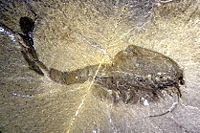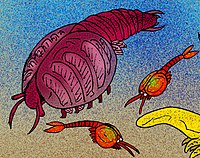Hymenocarina
| Hymenocarina Temporal range:
| |
|---|---|

| |
| Waptia | |
| Scientific classification | |
| Kingdom: | Animalia |
| Phylum: | Arthropoda |
| Clade: | Mandibulata |
| Order: | †Hymenocarina Størmer, 1944 |
| Genera | |
| Synonyms | |
|
Canadaspidida Novozhilov in Orlov, 1960 | |
Hymenocarina is an order of extinct arthropods known from the Cambrian. They possess bivalved carapaces with exposed posteriors, and look superficially like shrimp. Hymenocarines characterized by the combination of following characters: bivalved, convex carapace covering cephalothoracic region; cephalothorax bearing multisegmented antennules and rounded mandibles, alongside post-maxillular limbs with spiny, subdivided basis and endopods with well-developed terminal claws; absence of appendages between antennules and mandibles; median sclerite and lobate protrusions located between compound eyes; posterior tagma (abdomen) with ring-like segments and terminated by a pair of well-developed caudal rami.[1][2]
Taxonomy[]
Based on the interpretation of simple head region that possess only a few segments and appendages, hymenocarine taxa were thought to be part of the upper stem-group euarthropods in early and mid 2010s.[3][4][5][6][7][8][9][10] They later became widely accepted as mandibulates (jawed arthropods) after the discovery of their mandible-bearing mouthparts in late 2010s.[1][2][11][12] Since then, most phylogenetic analysis suggest hymenocarines represent part of the mandibulate stem-group,[1][13][2][14][15][16][17][18] with some results suggest a rather crownward position such as stem-pancrustaceans,[2][19][20][18] stem-myriapods,[2] stem-hexapods[16] or somewhere in-between the former taxa.[21]
Chuandianella, a genus thought to be a waptiid (and thus hymenocarine) for decades,[2][21] was reinterpreted as a non-hymenocarine euarthropod based on the crucial differences (e.g. subequal limbs; absence of mandibles) revealed by Zhai et al. 2022.[22]
Diversity[]
The group was very diverse in shape, with some forms like Waptia somewhat resembling shrimp,[2] and others like Odaraia having a large carapace and trifurcate tail.[23] The appendages showing various degrees of specialization across the group, ranging from the feathery gills of Waptia[2] to the robust claws of Tokummia.[1] They also had a wide range of sizes with some like Perspicaris reaching a length of around 0.9 inches long.[24] While other like Waptia and Odaraia reached lengths of 3.1 inches and 5.9 inches respectively.[25][26]
Gallery[]

Odaraia alta from the Burgess shale.

Waptia fieldensis from the Burgess shale.
The possible Hymenocarid Pectocaris spatiosa from the Maotianshan Shale.
Canadaspis perfecta from the Burgess shale alongside Waptia.
References[]
- ^ a b c d Aria, Cédric; Caron, Jean-Bernard (2017-04-26). "Burgess Shale fossils illustrate the origin of the mandibulate body plan". Nature. 545 (7652): 89–92. doi:10.1038/nature22080. ISSN 0028-0836. PMID 28445464. S2CID 4454526.
- ^ a b c d e f g h Vannier, Jean; Aria, Cédric; Taylor, Rod S.; Caron, Jean-Bernard (2018). "Waptia fieldensis Walcott, a mandibulate arthropod from the middle Cambrian Burgess Shale". Royal Society Open Science. 5 (6): 172206. doi:10.1098/rsos.172206. PMC 6030330. PMID 30110460.
- ^ Legg, David A.; Sutton, Mark D.; Edgecombe, Gregory D.; Caron, Jean-Bernard (2012-12-07). "Cambrian bivalved arthropod reveals origin of arthrodization". Proceedings of the Royal Society B: Biological Sciences. 279 (1748): 4699–4704. doi:10.1098/rspb.2012.1958. PMC 3497099. PMID 23055069.
- ^ Legg, David (2013). "Multi-Segmented Arthropods from the Middle Cambrian of British Columbia (Canada)". Journal of Paleontology. 87 (3): 493–501. doi:10.1666/12-112.1. ISSN 0022-3360.
- ^ Legg, David A.; Vannier, Jean (2013-09-16). "The affinities of the cosmopolitan arthropod Isoxys and its implications for the origin of arthropods". Lethaia. 46 (4): 540–550. doi:10.1111/let.12032. ISSN 0024-1164.
- ^ Legg, David A.; Sutton, Mark D.; Edgecombe, Gregory D. (2013-09-30). "Arthropod fossil data increase congruence of morphological and molecular phylogenies". Nature Communications. 4 (1): 2485. doi:10.1038/ncomms3485. ISSN 2041-1723.
- ^ Ortega-Hernández, Javier (2014-12-21). "Making sense of 'lower' and 'upper' stem-group Euarthropoda, with comments on the strict use of the name Arthropoda von Siebold, 1848". Biological Reviews. 91 (1): 255–273.
- ^ Ortega-Hernández, Javier; Janssen, Ralf; Budd, Graham E. (2017-05-01). "Origin and evolution of the panarthropod head – A palaeobiological and developmental perspective". Arthropod Structure & Development. Evolution of Segmentation. 46 (3): 354–379. doi:10.1016/j.asd.2016.10.011. ISSN 1467-8039.
- ^ Yang, Jie; Ortega-Hernández, Javier; Legg, David A.; Lan, Tian; Hou, Jin-bo; Zhang, Xi-guang (2018-02-01). "Early Cambrian fuxianhuiids from China reveal origin of the gnathobasic protopodite in euarthropods". Nature Communications. 9 (1): 470. doi:10.1038/s41467-017-02754-z. ISSN 2041-1723.
- ^ Daley, Allison C.; Antcliffe, Jonathan B.; Drage, Harriet B.; Pates, Stephen (2018-05-22). "Early fossil record of Euarthropoda and the Cambrian Explosion". Proceedings of the National Academy of Sciences. 115 (21): 5323–5331. doi:10.1073/pnas.1719962115. ISSN 0027-8424. PMID 29784780.
- ^ Giribet, Gonzalo; Edgecombe, Gregory D. (2019-06-17). "The Phylogeny and Evolutionary History of Arthropods". Current Biology. 29 (12): R592–R602. doi:10.1016/j.cub.2019.04.057. ISSN 0960-9822. PMID 31211983.
- ^ Edgecombe, Gregory D. (2020-11-02). "Arthropod Origins: Integrating Paleontological and Molecular Evidence". Annual Review of Ecology, Evolution, and Systematics. 51 (1): 1–25. doi:10.1146/annurev-ecolsys-011720-124437. ISSN 1543-592X.
- ^ Aria, Cédric; Caron, Jean-Bernard (2017-12-21). "Mandibulate convergence in an armoured Cambrian stem chelicerate". BMC Evolutionary Biology. 17 (1): 261. doi:10.1186/s12862-017-1088-7. ISSN 1471-2148. PMC 5738823. PMID 29262772.
- ^ Zeng, Han; Zhao, Fangchen; Niu, Kecheng; Zhu, Maoyan; Huang, Diying (2020-12-03). "An early Cambrian euarthropod with radiodont-like raptorial appendages". Nature. 588: 1–5. doi:10.1038/s41586-020-2883-7.
- ^ Aria, Cédric; Zhao, Fangchen; Zhu, Maoyan (2021-09-01). "Fuxianhuiids are mandibulates and share affinities with total-group Myriapoda". Journal of the Geological Society. 178 (5). doi:10.1144/jgs2020-246. ISSN 0016-7649.
- ^ a b Anderson, Evan P.; Schiffbauer, James D.; Jacquet, Sarah M.; Lamsdell, James C.; Kluessendorf, Joanne; Mikulic, Donald G. (2021-04-19). "Stranger than a scorpion: a reassessment of Parioscorpio venator, a problematic arthropod from the Llandoverian Waukesha Lagerstätte". Palaeontology. 64 (3): 429–474. doi:10.1111/pala.12534. ISSN 0031-0239.
- ^ Izquierdo‐López, Alejandro; Caron, Jean‐Bernard (2021-06-15). "A Burgess Shale mandibulate arthropod with a pygidium: a case of convergent evolution". Papers in Palaeontology. 7 (4): 1877–1894. doi:10.1002/spp2.1366. ISSN 2056-2799.
- ^ a b O'Flynn, Robert; Williams, Mark; Yu, Mengxiao; Harvey, Thomas; Liu, Yu (2022-02-11). "A new euarthropod with large frontal appendages from the early Cambrian Chengjiang biota". Palaeontologia Electronica. 25: a6. doi:10.26879/1167.
- ^ Aria, Cédric; Caron, Jean-Bernard (2019). "A middle Cambrian arthropod with chelicerae and proto-book gills". Nature. 573 (7775): 586–589. doi:10.1038/s41586-019-1525-4. ISSN 1476-4687.
- ^ Aria, Cédric; Zhao, Fangchen; Zeng, Han; Guo, Jin; Zhu, Maoyan (2020-01-08). "Fossils from South China redefine the ancestral euarthropod body plan". BMC Evolutionary Biology. 20 (1): 4. doi:10.1186/s12862-019-1560-7. ISSN 1471-2148. PMC 6950928. PMID 31914921.
- ^ a b Ou, Qiang; Vannier, Jean; Yang, Xianfeng; Chen, Aiiln; Huijuan, Mai; Shu, Degan; Han, Jian; Fu, Dongjing; Wang, Rong; Mayer, Georg (2020-04-29). "Evolutionary trade-off in reproduction of Cambrian arthropods". Science Advances. 6: 3376–3405. doi:10.1126/sciadv.aaz3376.
- ^ Zhai, Dayou; Williams, Mark; Siveter, David J.; Siveter, Derek J.; Harvey, Thomas H. P.; Sansom, Robert S.; Mai, Huijuan; Zhou, Runqing; Hou, Xianguang (2022-02-22). "Chuandianella ovata: An early Cambrian stem euarthropod with feather-like appendages". Palaeontologia Electronica. 25 (1): 1–22. doi:10.26879/1172. ISSN 1094-8074.
- ^ Briggs, D. E. G. (1981). "The Arthropod Odaraia alata Walcott, Middle Cambrian, Burgess Shale, British Columbia".
- ^ Budd, G. (2002). "A palaeontological solution to the arthropod head problem". Nature. 417 (6886): 271–275. Bibcode:2002Natur.417..271B. doi:10.1038/417271a. PMID 12015599. S2CID 4310080.
- ^ "Waptia fieldensis". Royal Ontario Museum. 2011. Retrieved January 14, 2012.
- ^ D. E. G. Briggs (1981). "The arthropod Odaraia alata Walcott, Middle Cambrian, Burgess Shale, British Columbia". Philosophical Transactions of the Royal Society B: Biological Sciences. 291 (1056): 541–582. Bibcode:1981RSPTB.291..541B. doi:10.1098/rstb.1981.0007. JSTOR 2395403.
- Cambrian first appearances
- Cambrian arthropods
- Prehistoric arthropod stubs



